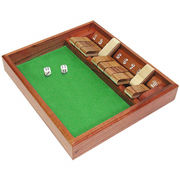 Shut The Box game
Shut The Box game
Shut the Box, Tric-Trac, Canoga (or Batten down the Hatches) is a game of dice for one or more players, mostly played in a group of two to four (possibly for stakes, gambling). Traditionally a counting box is used with tiles numbered 1 to 9 where each can be discreetly covered with a hinged or sliding mechanism. Alternatively it could be played with a sheet of paper. Variations exist where the box has up to 10 or 12 tiles.
Contents |
Play
On a turn a player repeatedly throws the dice to cover the tiles of the box, it ends when no tile can be covered on a throw and the players penalty score gets calculated. The goal is to cover all numbers, that is, "shut the box", which results in a penalty score of zero.
Rules
A round consists of each player playing a turn. At the start of a player's turn all tiles are uncovered. Two dice are rolled and the corresponding tile of partitioned numbers of the sum are covered, e.g., the dice show a 2 and a 3, so 5, 1 + 4 or 2 + 3 tiles could be covered. If every numbered tile higher than 6 is covered you could use one die. The turn ends if no tile could be covered on a throw of the dice.
Several rounds are played till all but one surpass a penalty score of, e.g., 45.
Variants
game ends:
- drop out over 45, where the uncovered numbers are added at the end of round to the player's penalty score and the lasting player wins.
- a round end winner system (gambling). If one is able to shut the box he wins immediately and gets the doubled stake of the others.
- 'long game' for two players. The first player tries to shut the box, where on the end of the turn the second player attempts to uncover the already covered numbers using the same rules. On a double throw the player gets an extra turn. The first one who reaches the goal wins.
penalty point scoring:
- are added together, e.g., uncovered 1, 5 and 9 equal 15
- direct read from the uncovered numbers instead of summing them, e.g., uncovered 1, 5 and 9 equal 159.
cover rules:
- any partitioned number could be turned down, e.g., if you throw a 6 and 3 any of the following sets could be turned down: 9; 1 + 8; 2 + 7; 3 + 6; 4 + 5; 1 + 2 + 6, ..., etc.
- the tiles of the sum or the single values of the dice are turned down.
- maybe enforce the single die option when the sum of the remaining numbers is less than six (partitioned number mode).
History
The origin is not known but there exist references from at least the 19th century to the Normandy (northern France) or the Channel Islands (English Channel, United Kingdom), others also mention fur trappers from the Hudson's Bay Company. The game has been popular among sailors and fishermen.
Evidence exists in England from the middle of the 20th century and it is quite sure that it did not originate there. Timothy Finn writes in Pub Games of England that it came from the Channel Islands in 1958 by a Mr. 'Chalky' Towbridge. It is said that versions have also been played in Barotseland (Zambia, central Africa). The game is also popular in the beer bars of Thailand.
Trivia
- Shut the Box was the basis of a television game show called High Rollers.
External links
Categories: Dice games




 216.73.216.81
216.73.216.81 User Stats:
User Stats:
 Today: 0
Today: 0 Yesterday: 0
Yesterday: 0 This Month: 0
This Month: 0 This Year: 0
This Year: 0 Total Users: 117
Total Users: 117 New Members:
New Members:
 216.73.xxx.xx
216.73.xxx.xx
 Server Time:
Server Time: